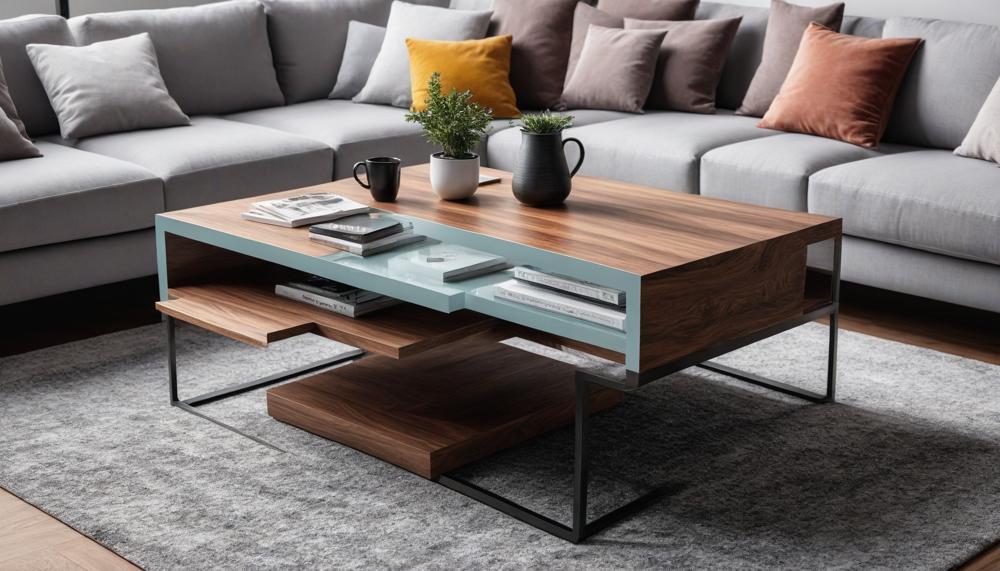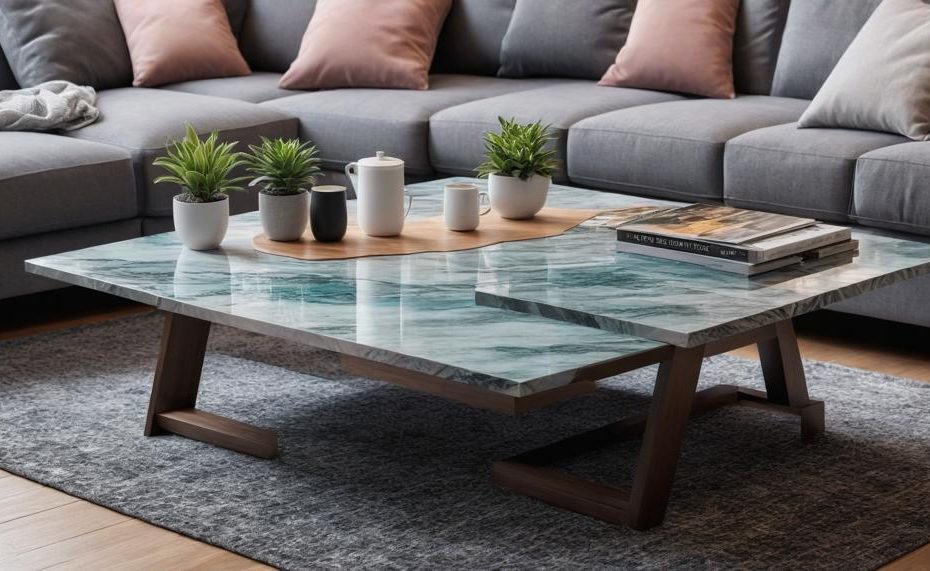Yes, your coffee table might be too big, and the effects are more significant than you might think. Imagine walking into a room where the coffee table dominates the space, making it difficult to move around and throwing off the balance of your carefully arranged furniture. An oversized coffee table can turn a cozy living area into a cramped and chaotic environment. But don’t worry; there are simple ways to find the perfect fit for your space.
The impact on room aesthetics and functionality is profound. A coffee table that’s too large can make your room feel crowded, disrupting the visual harmony and making it harder to use the space effectively. It can block the natural flow of traffic, creating awkward navigation paths and potentially leading to stubbed toes and frustrated guests.

To optimize space utilization and ensure smooth traffic flow, it’s essential to choose a coffee table that complements your room’s dimensions. Consider the distance between your seating and the table, allowing enough room for comfortable movement and access. A good rule of thumb is to leave at least 18 inches between the coffee table and the sofa, ensuring functionality without compromising style.
When selecting the right size, think about the scale of your furniture and the overall room size. A smaller room benefits from a sleek, compact coffee table, while a larger space can accommodate a more substantial piece without overwhelming the area. Measure your room and furniture before shopping to ensure your new coffee table is the perfect fit.
In short, the size of your coffee table can significantly influence your living space’s look and feel. By paying attention to room dimensions and traffic flow, you can create a balanced, inviting environment that enhances both style and functionality. Ready to find the right coffee table? Let’s dive into the specifics.
Contents
Be Mindful of the Height
To determine if your coffee table is too tall for your space, follow these guidelines:
- Height Comparison: Measure the height of your sofa cushions. Your coffee table should be the same height or 1-2 inches lower for optimal comfort.
- Spacing: Ensure there’s a comfortable distance of 12-18 inches between your sofa and the coffee table. This allows easy access without cramping the space.
- Overall Balance: Consider the weightiness and proportion. If your coffee table looks too imposing next to your sofa, it may be too tall. For sofas with high skinny legs, a shorter, chunkier legged table is better. Conversely, for sofas with no visible legs, a higher coffee table with skinnier legs works well.
- Functionality Test: Sit on your sofa and reach for the table. If you have to awkwardly bend or stretch, the table is likely too tall.
- Clearance: Make sure there’s at least 24-30 inches of space between your coffee table and other pieces like the TV stand or fireplace for easy movement.
Pay Attention to the Proportions
To determine if your coffee table is proportionate to your living room space, follow these key steps:
| Aspect | Guideline | Details |
| Height | Match sofa cushion height | Typically 16-18 inches |
| Length | Two-thirds of sofa length | Measure sofa length and multiply by 0.67 |
| Clearance | 12-18 inches from sofa, 24-30 inches from other furniture | Ensures easy movement and access |
| Width | Subtract 42 inches from sofa to TV stand length | Ideal width for proportionate fit |
| Weightiness | Balance with sofa legs | Solid table for high legs, skinny legs for no visible legs |
| Leggy Furniture | Limit high, skinny legs | Avoid too many leggy pieces |
Know Your Clearance Rules
To ensure your coffee table isn’t too large for your space, leave a clearance of approximately 18 to 24 inches (45 to 61 cm) between the coffee table and surrounding furniture. This space is crucial for comfortable foot traffic and ease of movement.
Here’s a detailed explanation to help you understand the importance of clearance around your coffee table:
- Comfortable Foot Traffic: Adequate space allows you and your guests to move around the coffee table without bumping into it or other pieces of furniture. A clearance of 18 to 24 inches provides ample room for walking and accessing seating areas.
- Visual Balance: Proper clearance ensures your coffee table doesn’t overwhelm the room, maintaining a balanced and aesthetically pleasing arrangement. It helps in keeping the area looking open and airy rather than cramped and cluttered.
- Functional Space: With enough space around your coffee table, you can easily reach for items placed on it without stretching or straining. This makes the table more functional for everyday use.
- Safety Considerations: Adequate clearance reduces the risk of tripping or knocking over the coffee table, making your living space safer, especially in homes with children or elderly individuals.
Strike the Right Balance
To determine if your coffee table is the right size for your space and furniture, follow these detailed steps:
- Measure Existing Furniture: Start by measuring your sofa and other key furniture pieces in the living room.
- Ideal Length: Your coffee table should be about two-thirds the length of your sofa. This ratio ensures balance and proportionality.
- Spacing: Leave 12-18 inches of space between the coffee table and the sofa. This distance allows for comfortable movement and access.
- Additional Clearance: Ensure there is a 30-inch gap between the coffee table and other pieces of furniture, such as a TV stand or entertainment center, for easy navigation and visual harmony.
- Calculating Width: Measure the distance from the sofa to other large furniture pieces. Subtract 48 inches (30 inches for clearance + 18 inches for sofa space) from this measurement to find the ideal width of your coffee table.
These steps will help you choose a coffee table that fits well within your living room, ensuring both functionality and aesthetic appeal.
Consider Your Own Needs
To determine if your coffee table is the right size for your needs and space, follow these detailed steps:
- Measure the Height: Your coffee table should be approximately the same height as the cushions on your sofa or slightly lower. This ensures comfort when reaching for items.
- Length Proportions: The length of the coffee table should be about two-thirds the length of your sofa. This maintains visual balance in the room.
- Spacing for Movement:
- Leave 12-18 inches of space between the coffee table and the sofa to allow for easy movement.
- Ensure at least 30 inches between the coffee table and other furniture pieces for comfortable foot traffic.
- Calculate the Width:
- Measure the distance from your sofa to the TV stand.
- Subtract 48 inches from this measurement to determine the maximum width of your coffee table. This calculation provides adequate space on both sides of the table for movement.
- Shape Considerations:
- Choose a shape that complements your room’s layout. For instance, round tables are great for smaller spaces or sectional sofas, while rectangular or oblong tables suit longer sofas.
- Practicality and Functionality: Consider your lifestyle and needs. If you frequently entertain guests, a larger table may be beneficial. If storage is a concern, look for tables with built-in shelves or drawers.
Choose Your Materials Carefully
When choosing materials for your coffee table to ensure it’s not too big for your space, focus on weight, visual weight, and flexibility. Opt for lighter materials like glass or acrylic to maintain an airy feel in smaller rooms. These materials also offer transparency, which can create a sense of openness.
Alternatively, consider materials with slim profiles such as metal or thin wood to reduce bulkiness without sacrificing sturdiness. Ensure the chosen material complements your existing furniture and decor to maintain harmony in your living area.
| Factors to Consider | Materials | Benefits |
| Weight | Glass, Acrylic | Light and airy feel, visual transparency |
| Visual Weight | Metal, Thin Wood | Slender profiles, reduced bulkiness |
| Flexibility | Adjustable materials | Adaptable to varying room sizes and layouts |
Conclusion
Choosing the right size for your coffee table is more crucial than you might think. An oversized coffee table can dominate your living room, making it difficult to move around and throwing off the balance of your carefully arranged furniture. This can transform a cozy area into a cramped, chaotic space. The size of your coffee table significantly impacts room aesthetics and functionality. A table that’s too large can disrupt the visual harmony and hinder effective use of the space. It can obstruct the natural flow of traffic, leading to awkward navigation paths and possibly even stubbed toes.
Optimizing space utilization and ensuring smooth traffic flow starts with selecting a coffee table that complements your room’s dimensions. Aim for a distance of at least 18 inches between your seating and the table, allowing for comfortable movement and access. Scale is essential: a smaller room benefits from a sleek, compact coffee table, while a larger space can accommodate a more substantial piece without overwhelming the area.
When choosing the right coffee table, consider the height, length, and overall proportions relative to your furniture. Ensuring that the table’s height matches or is slightly lower than your sofa cushions, and that it is about two-thirds the length of your sofa, maintains balance and functionality.





